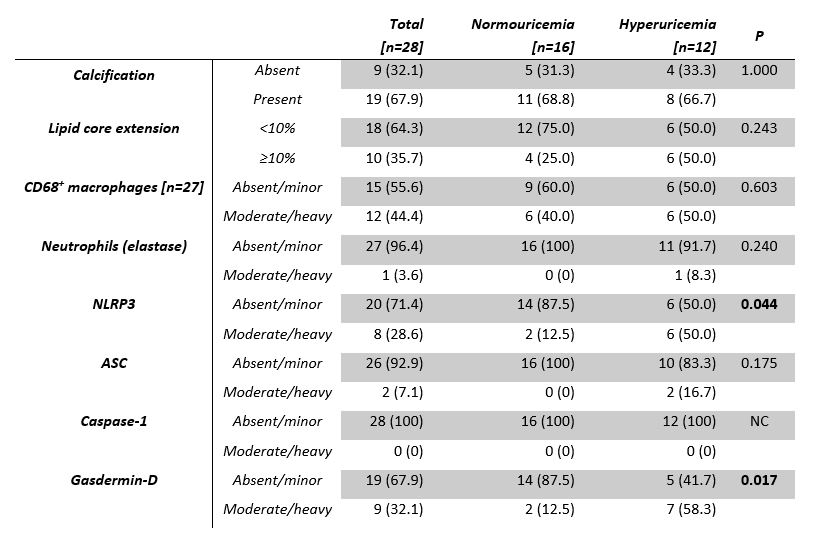Session Information
Date: Tuesday, November 9, 2021
Title: Metabolic & Crystal Arthropathies – Basic & Clinical Science Poster II (1565–1583)
Session Type: Poster Session D
Session Time: 8:30AM-10:30AM
Background/Purpose: Both hyperuricemia and monosodium urate crystals induce persistent inflammation. In vitro, soluble urate can prime innate immune cells and promote NLRP3 inflammasome activation and interleukin-1beta synthesis. These findings need to be confirmed in vivo, as they may help explain the gout-related cardiovascular risk. This study aimed to assess the inflammasome pathway activation at human atheroma plaques regarding the uricemic status.
Methods: Consecutive patients with severe peripheral arterial disease candidates to lower limb amputation were prospectively enrolled. Clinical and laboratory variables were collected; hyperuricemia was established at median serum urate (SU) levels ≥7 mg/dL; other levels, as normouricemia (NU). Patients under colchicine were excluded. A 5cm artery segment of the amputated limb was sampled during the surgical procedure and fixed by 100º absolute alcohol. H-E staining was used to study the degree of calcification, the extension of lipid cores, and the type of plaque according to the AHA grading (I-VI). Macrophages (CD68) and neutrophils (elastase), and the expression of inflammasome components (NLRP3, ASC, caspase-1 and gasdermin-D), were marked using commercial antibodies (Merck) for immunohistochemistry (IHC). Two pathologists reviewed the samples simultaneously, blinded to clinical data. IHC staining was categorized as absent/minor (staining with negative or clusters with< 10 cell present) or moderate/heavy (cell clusters with >10 cells present or abundance of positive cells) [PMID 30629987]. Comparisons were performed using chi-2 and Fisher’s exact tests.
Results: Out of 27 candidates, two were excluded (one for being on colchicine, the other for incomplete IHC process), so 25 participants were finally enrolled, median (IQR) aged 72.0 years (62.0-78.0), being 64.0% males. Ten patients (40%) were HU – two with gout – with a median SU of 7.6mg/dL (7.2-8.7), while 15 (60%) were NU, median SU of 4.4 (3.4-5.0). No patient was on urate-lowering drugs. Twenty-eight artery samples were available (16 from NU, 12 from HU), predominantly from popliteal arteries in both groups (50.0% in NU, 83.3% in HU). Type V (fibroatheroma) were the most common lesions seen in both cases (43.8% in NU, 50.0% in HU). The H-E and immunostaining findings and comparisons between study groups are shown in the Table. Similar calcification and lipid extension were seen. No differences were noted on macrophages distribution, while neutrophils were scarce in the samples. Interestingly, in regards to the inflammasome pathway, the plaque content of NLRP3 and gasdermin-D was significantly larger in those with HU. ASC content was numerically larger in HU as well, while caspase-1 was scantly stained in both groups.
Conclusion: HU was revealed associated with a higher NLRP3 and gasdermin-D expression at human atheroma plaques in patients with peripheral artery disease. This finding needs further replication but may contribute to understanding the relationship between gout and atherosclerosis.
 Table. Pathology findings at atheroma plaques by hematoxylin-eosin and immunostaining, and the comparisons between study groups of uricemia.
Table. Pathology findings at atheroma plaques by hematoxylin-eosin and immunostaining, and the comparisons between study groups of uricemia.
To cite this abstract in AMA style:
ANDRES M, Mendieta L, Argente-delcastillo E, Trigueros M, Miñano A. NLRP3 Inflammasome Pathway Expression at Atheroma Plaques from Peripheral Artery Disease According to the Uricemic Status [abstract]. Arthritis Rheumatol. 2021; 73 (suppl 9). https://acrabstracts.org/abstract/nlrp3-inflammasome-pathway-expression-at-atheroma-plaques-from-peripheral-artery-disease-according-to-the-uricemic-status/. Accessed .« Back to ACR Convergence 2021
ACR Meeting Abstracts - https://acrabstracts.org/abstract/nlrp3-inflammasome-pathway-expression-at-atheroma-plaques-from-peripheral-artery-disease-according-to-the-uricemic-status/
